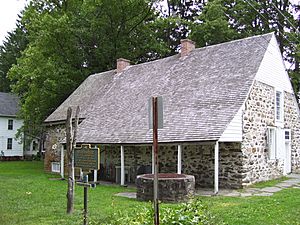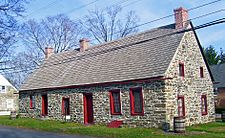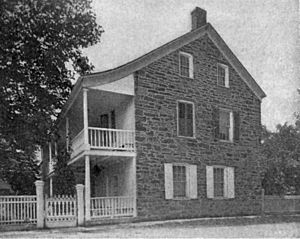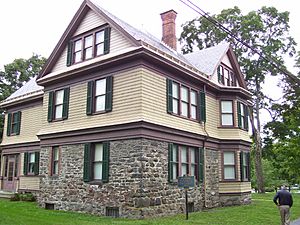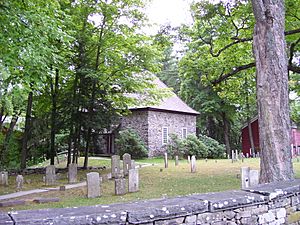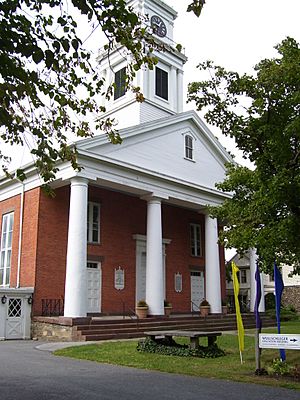Huguenot Street Historic District facts for kids
|
Historic Huguenot Street
|
|
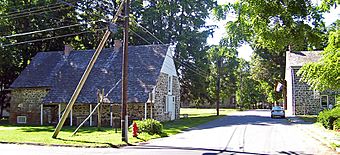
The Bevier-Elting House, left, and Dubois Fort, location of the Visitor Center at Historic Huguenot Street
|
|
| Location | New Paltz, New York |
|---|---|
| Nearest city | Poughkeepsie |
| Area | 10 acres (4.0 ha) |
| Built | Founded 1678. Houses date to ca1705. |
| Architectural style | Dutch-style colonial; Georgian. |
| Visitation | 16,500 (2007) |
| NRHP reference No. | 66000578 |
Quick facts for kids Significant dates |
|
| Added to NRHP | October 15, 1966 |
| Designated NHLD | October 9, 1960 |
Historic Huguenot Street is a special place in New Paltz, New York. It's about 90 miles (145 km) north of New York City. This historic area has seven old stone houses and other buildings. They were built in the early 1700s by Huguenot settlers.
Huguenots were French Protestants who came to America. They were looking for a safe place to live. They faced unfair treatment and religious persecution in France and what is now southern Belgium. In 1678, this small group of Huguenots settled here. They chose a spot by the Wallkill River after talking with the Esopus Indians. They named their new home "New Paltz" after a region in Germany called Die Pfalz. This area had given them a safe place to stay before they came to America.
Scientists have found signs that Native Americans lived here long before the Europeans arrived. Historic Huguenot Street is one of the oldest places in the United States where people have lived continuously.
Exploring Historic Huguenot Street
The old houses on Historic Huguenot Street are still in their original village setting. This street became part of the National Register of Historic Places in 1966. It was named a National Historic Landmark in 1960.
The site covers 10 acres (4 hectares). Besides the houses, you can find:
- A burying ground from the early 1700s.
- A stone church rebuilt to look like the one from 1717.
- A visitor center.
- A library and archives.
- Spaces for special events and learning programs.
The Historic Huguenot Street organization owns and runs the site. It was started in 1894. In 1899, they bought the Jean Hasbrouck house. It was the first house museum on the street. In the 1950s and 60s, the organization bought most of the other stone houses. They opened them as museums too. Many of these purchases were paid for by the families of the original Huguenot settlers. These family groups still help support the site today. Since the 1980s, the organization has offered educational programs to the public.
The Historic Houses of Huguenot Street
Bevier-Elting House
This house was built in the early 1700s. It started as a single room with the narrow side facing the street. This was a common style in Northern Europe back then. Later, two more parts were added. It also had a small cellar where African slaves lived. The Bevier family, one of the founding families, built the house. It was later sold to the Dutch Elting family.
Abraham Hasbrouck House
The Abraham Hasbrouck House was built in three stages during the 1720s and 1730s. The middle room was built first, in 1721. Daniel Hasbrouck, Abraham Hasbrouck's son, built it. We know the date thanks to dendrochronology. This is a way to date wooden parts of a building by looking at tree rings.
This house shows a new way of building Dutch-style homes in America. Early Dutch houses in places like New Amsterdam (now New York City) were built with the narrow end facing the street. This saved space along the street. The Abraham Hasbrouck House has a special design with H-shaped frames. These frames help spread the weight of the house. A unique feature of this house is its "jambless fireplace." This type of fireplace does not have sides (jambs) that stick out. It is one of the most recognized features of Dutch architecture. The house was reopened in July 2012. Its new exhibits focus on the life of Widow Wyntje, who lived there.
Jean Hasbrouck House
This house was also built in 1721 by Jacob, Jean Hasbrouck's son. It might even include parts of an earlier home built by Jean Hasbrouck, a founder of New Paltz. This house is a great example of Dutch architecture from the Hudson Valley. It is a main attraction at Historic Huguenot Street. It is also a National Historic Landmark on its own. It has the only original "jambless fireplace" left among the Huguenot Street houses. This type of fireplace is rare in what was once New Netherland.
In 2006, the north wall of the house was carefully taken apart and fixed. New Dutch-style windows were put in. The inside was also restored. Now, the house shows how a comfortable family lived in the mid-1700s.
DuBois Fort
The DuBois family built this house around 1705. Some people think it might have been used as a fort to protect the community. It was originally a smaller building. It was made bigger in the late 1830s. Some historians thought it had "gun ports" for defense. But there is no proof of these until the 1800s.
Today, the DuBois Fort is the visitor center and gift shop. You can buy tickets and memberships here. It also hosts special events. Over the past 300 years, it has been a home and a restaurant too.
Freer House
The Freer House is one of the six stone houses from the 1700s owned by Historic Huguenot Street. It was changed many times over its 250 years of being lived in. The biggest changes happened in 1943. That's when Rev. John Wright Follette bought it. He was a direct descendant of Hugo Freer, who first built the house. Over the years, the inside was updated to look like a 20th-century idea of a colonial home. This house is not open to the public right now.
Deyo House
The first part of this house was built around 1720 by Pierre Deyo. He was one of the original land owners. It started as one room, then grew to two, and finally three rooms. Pierre's grandson, Abraham, added a stone part to the back.
The house changed a lot when Abraham and Gertrude Brodhead inherited it. They were also descendants of Pierre Deyo. They wanted to live on their ancestors' street but also wanted a modern, fancy home. So, in 1894, they partly took down the original stone house. Then, they built a grand Queen Anne style home around it. They also changed their property. It went from a small village farm to a beautiful mini-estate with gardens. The Deyo family stopped owning the house in 1915. It was a private home until 1971. Then, the Deyo Family Association bought it and gave it to be a museum. The house was last restored in 2003. It shows how homes looked around 1915.
The original land owner, Pierre Deyo, died in 1700. So, he could not have built the house in 1720. A plaque outside the house says it was built in 1692.
Crispell Memorial Walloon Church
Since New Paltz was founded, four churches have been built on Huguenot Street. The French-speaking Protestants built their first church in 1683. It was a simple log building. In 1717, a square stone building replaced it. This showed that the settlement was becoming permanent. The building you see today in the burying ground is a guess at what the 1717 church looked like. It is built near the original spot.
As New Paltz grew in the 1700s, a bigger church was needed. A second stone church was built down the street in 1772. When it became too small, it was taken down. A third church was built in 1839. This church is still standing today. It is home to an active Reformed congregation.
The rebuilt church is named after Antoine Crispell. He was one of the twelve founders of New Paltz. It was built after a fundraising effort by the Crispell Family Association. They wanted to honor their ancestor. The church was finished in 1972.
The 1717 church was designed to show "Reform thinking." The pulpit (where the speaker stands) was in the middle. The pews (benches) were placed so everyone could see and hear equally. This showed the idea that each person had a direct connection with God. It was not through a church leader.
LeFevre House
Ezekiel Elting built this stone and brick house in 1799. He was a successful merchant born in the Bevier-Elting House. This house looks very different from the earlier stone houses on Huguenot Street. Its Georgian-style architecture shows how New Paltz was changing. It was moving from a French and Dutch settlement to an Anglo-American community. It also shows how architecture became more refined as settlements grew older. This house reflects changes in society and home life in New Paltz in the early 1800s.
Deyo Hall
Deyo Hall used to be a glass factory. Now, it is used for events and meetings. It also has public restrooms. The building also stores collections of historical items.
Roosa House Library and Archives
The Library and Archives are located in the Roosa House. It is a research center at Historic Huguenot Street. It mainly focuses on the history and family trees of the Huguenot and Dutch settlers of the Hudson Valley. It also keeps local history records for everyone, no matter their background. The collections include:
- Family histories.
- Church, cemetery, and bible records.
- Wills and property deeds.
- Census records.
- Family history magazines.
- County histories.
- Books about Huguenot ancestors.
People interested in family history or local history can visit by appointment. The colorful paint on the house matches its original colors from 1891.
Native American History on Huguenot Street
Historians and archeologists have learned a lot about the ongoing relationship between the Esopus Indians and the Huguenots. The Esopus were the first people to live in this area. You can find some research results on the Historic Huguenot Street website. The "Before Hudson" exhibit is at the DuBois Fort Visitor Center. It shows exciting finds from archaeological digs in the area. Some artifacts found are 6,000 to 8,000 years old.
Slavery in New Paltz's History
The history of slavery in New Paltz began in 1674. This was three years before the town was founded. Louis DuBois bought two African slaves at a public sale in Kingston. The two slaves ran away the next spring. They were later found by Lewis Morris. From 1675 to 1680, Morris and DuBois had a long dispute over who owned the two slaves.
Settlers continued to buy slaves to work as laborers in New Paltz. This helped the settlement grow. The Deyo family bought slaves in 1680 and 1694. For the next 125 years, historical records of the settlement mention slaves. In 1703, nine out of 130 residents were slaves. Jean and Jacob Hasbrouck owned several slaves. Their names, "Gerritt," "James," and "Molly," were in Jean's will. By 1755, slavery was a big part of the New Paltz community. A count from that year lists 28 slave owners. They owned 78 slaves who were over 14 years old. Most slave owners (82%) had one to four slaves. These slaves worked as house servants and farm laborers.
The total population of New Paltz grew quickly to 2,309 people by 1790. At that time, 77 slave owners had a total of 302 slaves. This meant 13% of the population were slaves. You can find more information about slavery in New Paltz on the Historic Huguenot Street website. They also have an online exhibit called The Missing Chapter: Untold Stories of the African-American Presence in the Mid-Hudson Valley.
See also
- Major Jacob Hasbrouck Jr. House, a home built by Jean Hasbrouck's grandson. It is located further up Huguenot Street.




